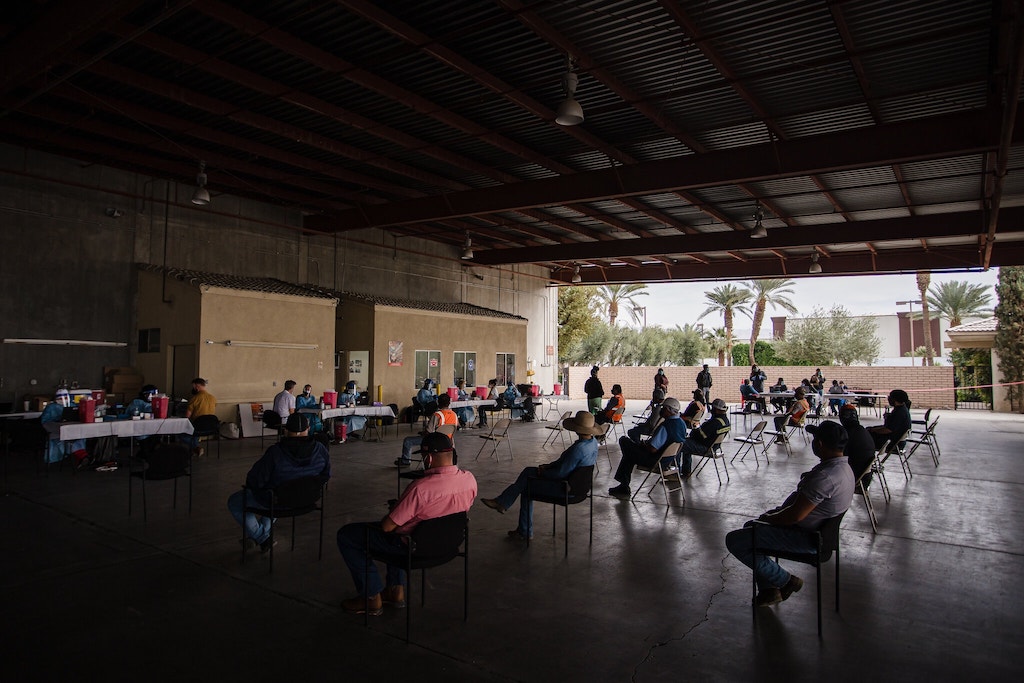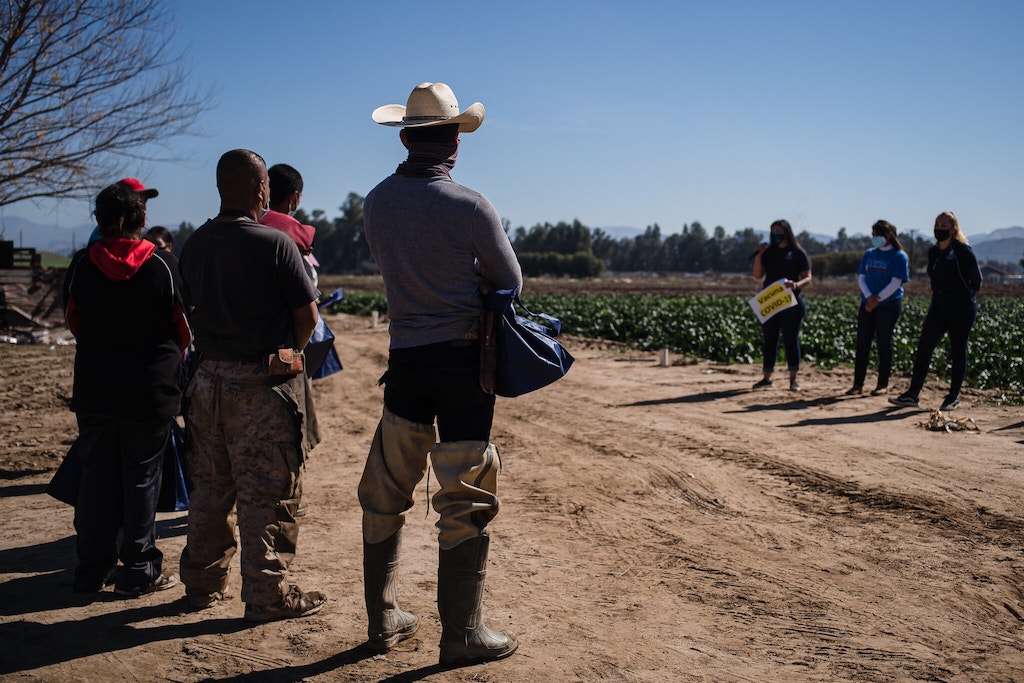 The rollout of the COVID-19 vaccine has been historic. It was created in record time with international public and private cooperation. With the recent approval of the Johnson & Johnson single-dose vaccine, there are currently three vaccines authorized to be distributed and administered in the United States. Vaccine data, information, and guidelines are being updated daily, and on March 2nd President Biden vowed that there will be enough supply for all adult Americans to receive the vaccine by the end of May. However, even if we meet this ambitious goal, there will still be thousands of people who die and many more infected with this disease before widespread vaccination is achieved. This is why thoughtful vaccine distribution now is vital to saving as many lives as possible, especially with an end in sight, and why agricultural workers need to be at the top of the list as an immediate priority.
The rollout of the COVID-19 vaccine has been historic. It was created in record time with international public and private cooperation. With the recent approval of the Johnson & Johnson single-dose vaccine, there are currently three vaccines authorized to be distributed and administered in the United States. Vaccine data, information, and guidelines are being updated daily, and on March 2nd President Biden vowed that there will be enough supply for all adult Americans to receive the vaccine by the end of May. However, even if we meet this ambitious goal, there will still be thousands of people who die and many more infected with this disease before widespread vaccination is achieved. This is why thoughtful vaccine distribution now is vital to saving as many lives as possible, especially with an end in sight, and why agricultural workers need to be at the top of the list as an immediate priority.
When the COVID-19 pandemic hit the United States and our understanding of the necessary precautions began to take shape, it became clear that agricultural workers were going to be at especially high risk for the disease. While many of us began to work from home and pivot to accommodate public health guidelines, the giant locomotive that is US agricultural production never slowed, making ad hoc adjustments and learning on the fly to varying degrees of success. In most cases, if you were an agricultural worker who felt unsafe, you had to decide between losing wages (and likely your job) and protecting yourself and your family.
Fast forward to today, almost exactly a year later, and agricultural workers remain at exceptionally high risk for contracting COVID-19. The barriers to practice physical distancing, poor distribution and enforcement of personal protective equipment (PPE), and a complete failure to provide culturally and linguistically appropriate educational materials has made agricultural workers among the hardest hit populations in the country. A recent study from the University of California, San Francisco examined excess mortality by race/ethnicity and job sector for those aged 18-65 in California during the pandemic – that is, they examined how many more deaths occurred than during a typical, pre-pandemic period. It was found that Latinos working in food and agriculture experienced a 59% increase in mortality, by far the highest percentage of any subgroup studied. This study looked at data from March – October 2020. Given that November 2020 – January 2021 were the deadliest months of the disease, it is safe to say this figure might be much worse.
 Since the first American received a vaccine in December 2020, the conversation around who should be prioritized for the limited available doses has been a hot topic of discussion. The actual distribution and rollout from the federal level has been clunky at best, and very much in-line with the way the pandemic guidelines and precautions were handled: leave it up to states and local jurisdictions. This created incredibly divergent guidelines from one place to the next, and led to rampant cross-community spread. Now with vaccine distribution, once again we are left to figure it out for ourselves – one state to the next and one community to the next – and it’s no wonder that there has been little consistency.
Since the first American received a vaccine in December 2020, the conversation around who should be prioritized for the limited available doses has been a hot topic of discussion. The actual distribution and rollout from the federal level has been clunky at best, and very much in-line with the way the pandemic guidelines and precautions were handled: leave it up to states and local jurisdictions. This created incredibly divergent guidelines from one place to the next, and led to rampant cross-community spread. Now with vaccine distribution, once again we are left to figure it out for ourselves – one state to the next and one community to the next – and it’s no wonder that there has been little consistency.
Most of the country appears to be in “Phase 1B” of the CDC’s rollout recommendations, which prioritizes essential workers and older adults. However, as the scope broadens, so does the opportunity for interpretation and opinion by each authority and jurisdiction. Only in the last week or two, agricultural workers in certain areas are very slowly being able to access the vaccine, such as in California where there is estimated to be over 1 million agricultural workers. However, this is entirely up to the state and local governments in question, and many have chosen to not yet include them for vaccine approval.
Agricultural work is already one of the job sectors with the highest occupational health risks. Strenuous physical labor, exposure to pesticides, usage of dangerous tools, and harsh weather conditions are only a few of the many risk factors that lead to elevated illness, injury, and death compared to other occupations. Furthermore, it is estimated that over 75% of agricultural workers are immigrants, and almost 50% are undocumented. This excludes vast numbers of agricultural workers from the majority of government support, including any COVID-19 stimulus benefits, in an industry that already has shamefully low worker protections in place, such as paid sick leave or health insurance access. This creates compounding conditions that make the disproportionate health impacts of COVID-19 so widely felt across the agricultural worker community.
In order to maintain a well-stocked refrigerator, and to do so at value, we demand super human production out of a labor force we shamefully under value. When people’s lives are left in the hand of politicians playing to their base, we are leaving this life-or-death decision up to systems tainted with deep-seated racism and prejudice against latinos, low-wage labor forces, and those without documentation. In an article from The Counter explaining how New York State recently removed agricultural workers from their latest vaccine priority, this passage demonstrates ways fickle politicians are allowed to create such racist and varied approaches from state to state:
In Nebraska, Governor Pete Ricketts said that undocumented meatpacking workers would be ineligible to receive the vaccine (he later clarified through a spokesperson that proof of citizenship would not be required for a vaccination, but that Nebraska would prioritize citizens and legal residents ahead of undocumented immigrants). In Arizona, Rep. Debbie Lesko came under fire for her racist comment during a congressional hearing that although she has “worked with people that are Hispanic… we have to take care of American citizens, or people that are here legally, first.”
 The time is now to prioritize agricultural workers for the vaccine across all states and communities. The coming of spring begins crop seasons around the country, and the need for work will steadily increase starting now until the end of summer. This means agricultural workers will be interacting with one another more and moving more often, greatly increasing opportunities to spread the disease. In addition, the Pfizer and Moderna vaccines require two doses administered weeks apart. If we wait too long to grant agricultural workers access to the vaccine, many may find themselves moving again before they are able to receive the second dose.
The time is now to prioritize agricultural workers for the vaccine across all states and communities. The coming of spring begins crop seasons around the country, and the need for work will steadily increase starting now until the end of summer. This means agricultural workers will be interacting with one another more and moving more often, greatly increasing opportunities to spread the disease. In addition, the Pfizer and Moderna vaccines require two doses administered weeks apart. If we wait too long to grant agricultural workers access to the vaccine, many may find themselves moving again before they are able to receive the second dose.
Even if someone could wave a magic wand and tomorrow all 2.5 million agricultural workers in the US were vaccinated, that would not come close to correcting the injustices this population experiences. There is still no access to government benefits for the majority of agricultural workers. There is still no formal law for a path to citizenship for children brought to this country due to no decision of their own (despite bipartisan support for DACA.) Agricultural workers are still excluded from some of the most basic of US labor protections, such as right to overtime and child labor laws (yes, really.) US international policy still breeds the conditions in other countries that cause many immigrants to come to this country in the first place without a safety net in place.
What the vaccine will do is finally prioritize this population who was so under-prioritized at the beginning of the pandemic. Yet they continued to show up to work despite the hazardous conditions and the confusing and ever-changing public health guidelines. They kept grocery stores and restaurants open, and they kept the nation fed. Unfortunately, many have paid the ultimate price. This is something we cannot undo. However, we can control how many more agricultural workers fall victim to this horrible disease, and, for once, we need to take care of them the same way they have taken care of us.
By Project Manager Liam Spurgeon for HOP’s series of monthly staff blog posts.
Images source: New York Times

Well said! About time we respect those who work so hard for this country.